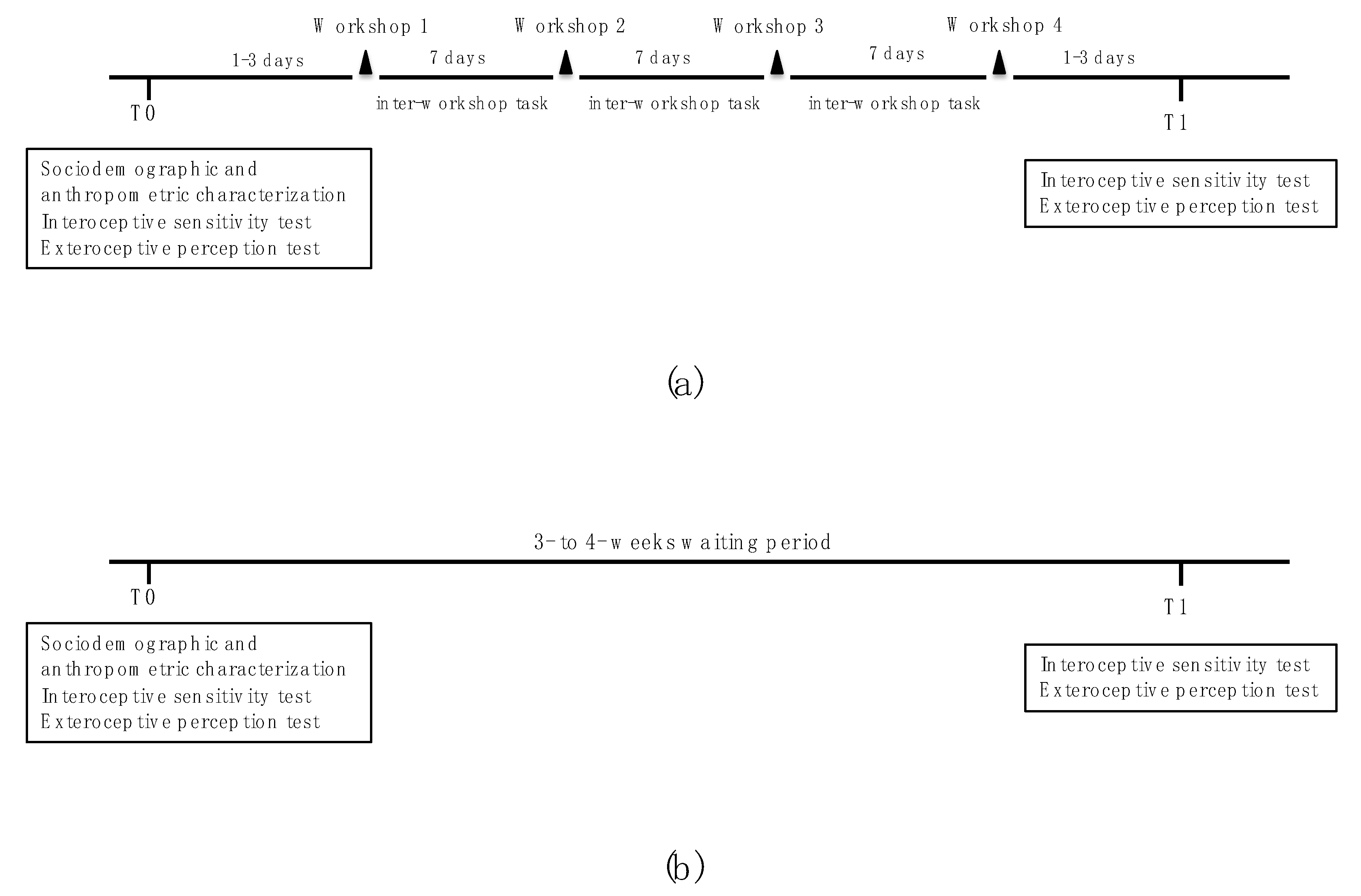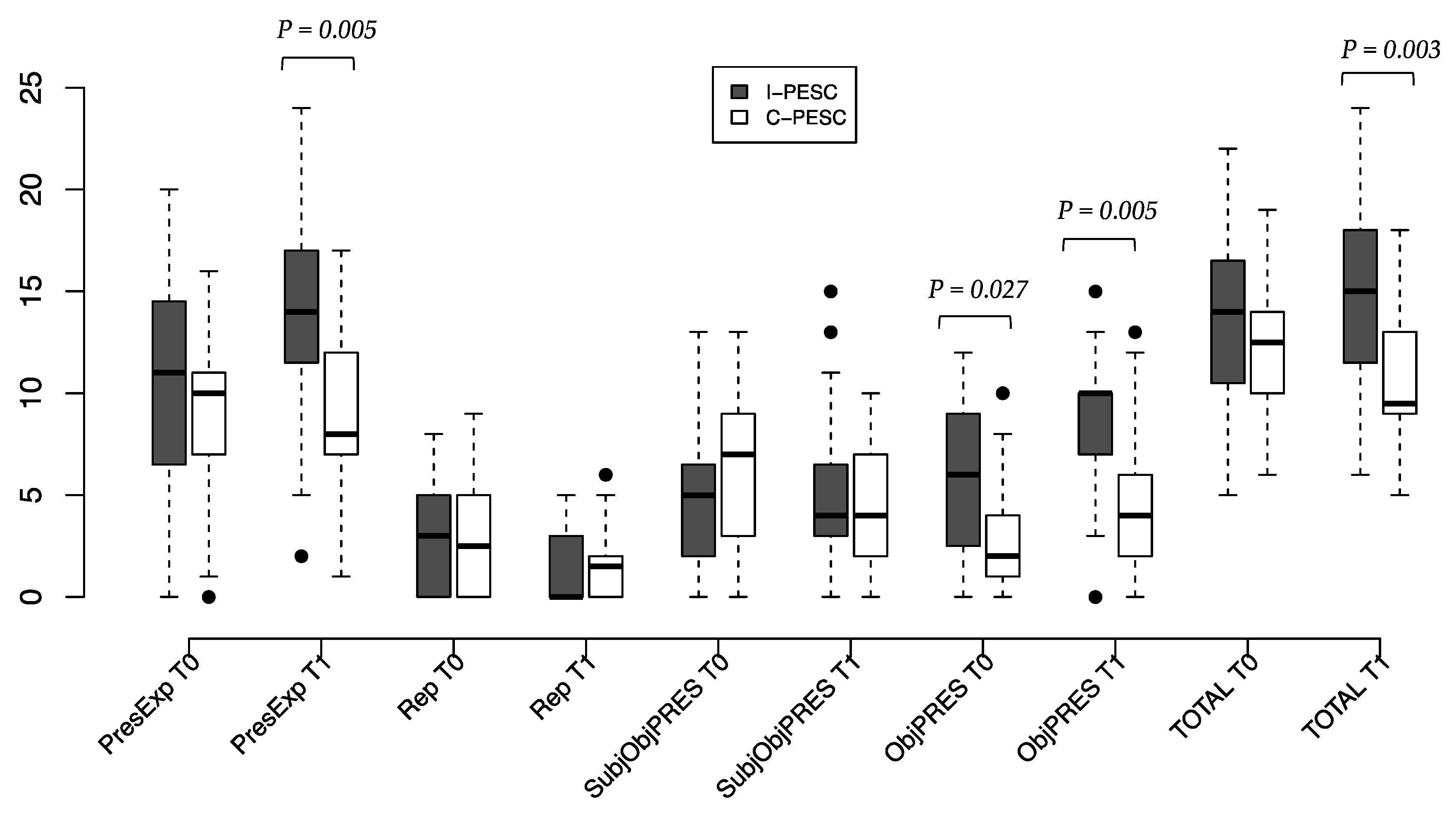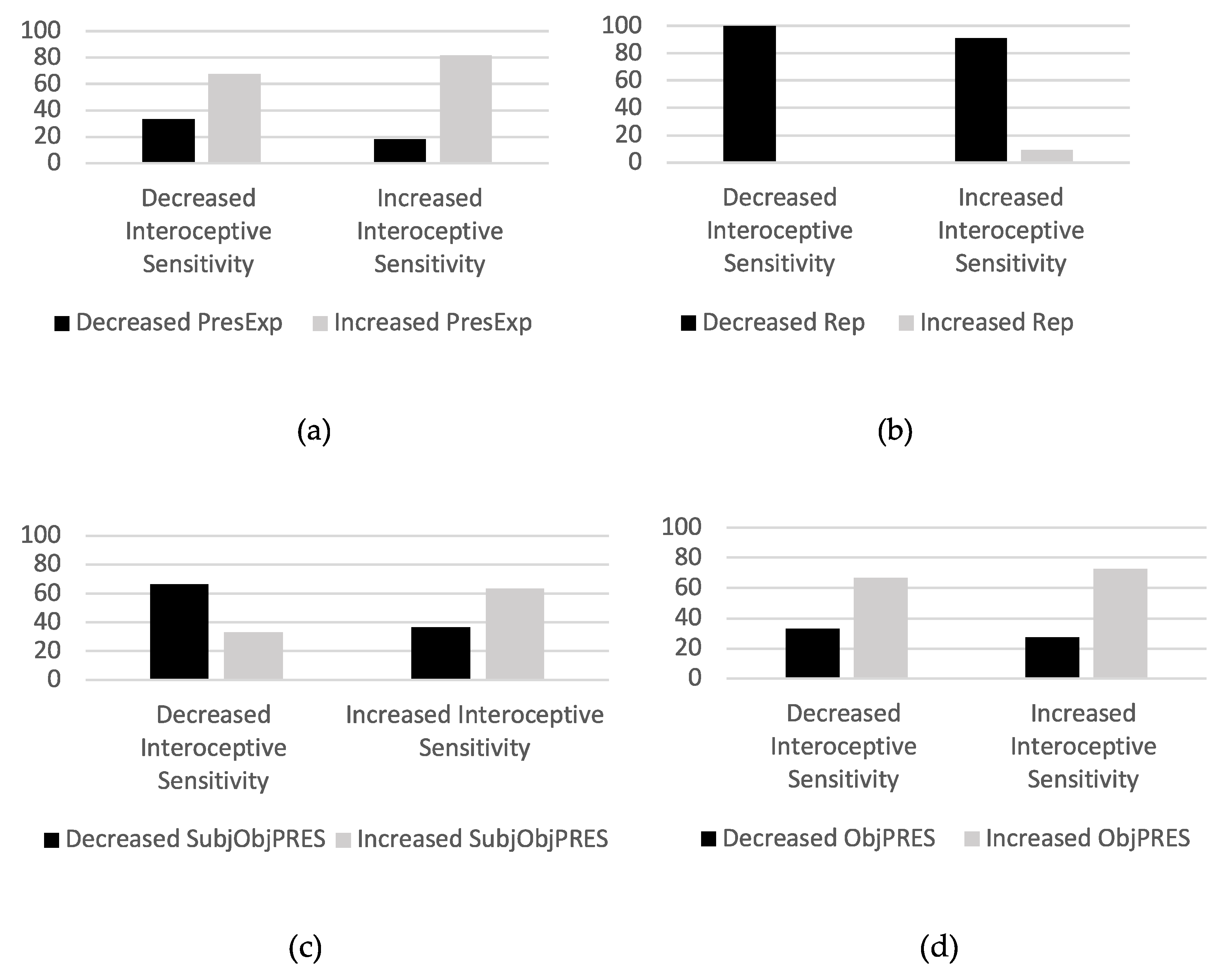Food Consciousness Intervention Improves Interoceptive Sensitivity and Expression of Exteroception in Women
Abstract
:1. Introduction
2. Materials and Methods
2.1. Participants and Study Design
2.2. PESC
2.3. Sociodemographic and Anthropometric Characterization
2.4. Interoceptive Sensitivity
2.5. Exteroceptive Perception
2.6. Data Analysis
2.6.1. Produced Text Analysis
2.6.2. Statistical Analysis
3. Results
3.1. Sample Characterization
3.2. Interpceptive Sensitivity
3.3. Exteroception Perception
3.4. Interoceptive Sensitivity X Exteroceptive Perception
4. Discussion
5. Conclusions
Author Contributions
Funding
Institutional Review Board Statement
Informed Consent Statement
Data Availability Statement
Acknowledgments
Conflicts of Interest
References
- Mann, T.; Tomiyama, A.J.; Westling, E.; Lew, A.M.; Samuels, B.; Chatman, J. Medicare’s search for effective obesity treatments: Diets are not the answer. Am. Psychol. 2007, 62, 220–233. [Google Scholar] [CrossRef]
- Clifford, D.; Ozier, A.; Bundros, J.; Moore, J.; Kreiser, A.; Morris, M.N. Impact of non-diet approaches on attitudes, behaviors and health outcomes: A systematic review. J. Nutr. Educ. Behav. 2015, 47, 143–155. [Google Scholar] [CrossRef]
- Shepherd, G. Neurogastronomy; Columbia University Press: New York, NY, USA, 2012. [Google Scholar]
- Simmons, W.K.; DeVille, D.C. Interoceptive contributions to healthy eating and obesity. Curr. Opin. Psychol. 2017, 17, 106–112. [Google Scholar] [CrossRef] [PubMed]
- Craig, A.D. How do you feel? Interoception: The sense of the physiological condition of the body. Nat. Rev. Neurosci. 2002, 3, 655–666. [Google Scholar] [CrossRef] [PubMed]
- Weltens, N.; Zhao, D.; Van Oudenhove, L. Where is the comfort in comfort foods? Mechanisms linking fat signaling, reward, and emotion. Neurogastroenterol. Motil. 2014, 26, 303–315. [Google Scholar] [CrossRef]
- Craig, A.D. How do you feel–now? The anterior insula and human awareness. Nat. Rev. Neurosci. 2009, 10, 59–70. [Google Scholar] [CrossRef]
- Mehling, W.E.; Gopisetty, V.; Daubenmier, J.; Price, C.J.; Hecht, F.M.; Stewart, A. Body awareness: Construct and self-report measures. PLoS ONE 2009, 4, e5614. [Google Scholar] [CrossRef] [PubMed] [Green Version]
- Morton, G.J.; Cummings, D.E.; Baskin, D.G.; Barsh, G.S.; Schwartz, M.W. Central nervous system control of food intake and body weight. Nature 2006, 443, 289–295. [Google Scholar] [CrossRef]
- Rolls, E.T. Understanding the mechanisms of food intake and obesity. Obes. Rev. 2007, 8 (Suppl. 1), 67–72. [Google Scholar] [CrossRef]
- Rolls, E.T. Brain mechanisms underlying flavour and appetite. Philos. Trans. R. Soc. Lond B Biol. Sci. 2006, 361, 1123–1136. [Google Scholar] [CrossRef] [Green Version]
- Rolls, E.T. Taste, olfactory and food texture reward processing in the brain and the control of appetite. Proc. Nutr. Soc. 2012, 71, 488–501. [Google Scholar] [CrossRef] [Green Version]
- Cabanac, M. Physiological role of pleasure. Science 1971, 173, 1103–1107. [Google Scholar] [CrossRef]
- Rolls, B.J.; Rolls, E.T.; Rowe, E.A.; Sweeney, K. Sensory specific satiety in man. Physiol. Behav. 1981, 27, 137–142. [Google Scholar] [CrossRef]
- De Araujo, I.E.; Rolls, E.T.; Velazco, M.I.; Margot, C.; Cayeux, I. Cognitive modulation of olfactory processing. Neuron 2005, 46, 671–679. [Google Scholar] [CrossRef] [Green Version]
- Zheng, H.; Lenard, N.R.; Shin, A.C.; Berthoud, H.R. Appetite control and energy balance regulation in the modern world: Reward-driven brain overrides repletion signals. Int. J. Obes. 2009, 33 (Suppl. 2), S8–S13. [Google Scholar] [CrossRef] [Green Version]
- Herbert, B.M.; Pollatos, O. Attenuated interoceptive sensitivity in overweight and obese individuals. Eat. Behav. 2014, 15, 445–448. [Google Scholar] [CrossRef]
- Kleckner, I.R.; Wormwood, J.B.; Simmons, W.K.; Barrett, L.F.; Quigley, K.S. Methodological recommendations for a heartbeat detection-based measure of interoceptive sensitivity. Psychophysiology 2015, 52, 1432–1440. [Google Scholar] [CrossRef] [Green Version]
- Stice, E.; Spoor, S.; Bohon, C.; Small, D.M. Relation between obesity and blunted striatal response to food is moderated by TaqIA A1 allele. Science 2008, 322, 449–452. [Google Scholar] [CrossRef] [Green Version]
- Pollatos, O.; Kurz, A.L.; Albrecht, J.; Schreder, T.; Kleemann, A.M.; Schöpf, V.; Kopietz, R.; Wiesmann, M.; Schandry, R. Reduced perception of bodily signals in anorexia nervosa. Eat. Behav. 2008, 9, 381–388. [Google Scholar] [CrossRef]
- Pollatos, O.; Georgiou, E. Normal interoceptive accuracy in women with bulimia nervosa. Psychiatry Res. 2016, 240, 328–332. [Google Scholar] [CrossRef]
- Kittel, R.; Brauhardt, A.; Hilbert, A. Cognitive and emotional functioning in binge-eating disorder: A systematic review. Int. J. Eat. Disord. 2015, 48, 535–554. [Google Scholar] [CrossRef]
- Lake, A.; Townshend, T. Obesogenic environments: Exploring the built and food environments. J. R. Soc. Promot. Health 2006, 126, 262–267. [Google Scholar] [CrossRef]
- Wansink, B. From mindless eating to mindlessly eating better. Physiol. Behav. 2010, 100, 454–463. [Google Scholar] [CrossRef] [PubMed]
- Herbert, B.M.; Blechert, J.; Hautzinger, M.; Matthias, E.; Herbert, C. Intuitive eating is associated with interoceptive sensitivity. Effects on body mass index. Appetite 2013, 70, 22–30. [Google Scholar] [CrossRef] [PubMed]
- Werner, N.S.; Jung, K.; Duschek, S.; Schandry, R. Enhanced cardiac perception is associated with benefits in decision-making. Psychophysiology 2009, 46, 1123–1129. [Google Scholar] [CrossRef]
- Pollatos, O.; Traut-Mattausch, E.; Schroeder, H.; Schandry, R. Interoceptive awareness mediates the relationship between anxiety and the intensity of unpleasant feelings. J. Anxiety Disord. 2007, 21, 931–943. [Google Scholar] [CrossRef]
- Pollatos, O.; Herbert, B.M.; Matthias, E.; Schandry, R. Heart rate response after emotional picture presentation is modulated by interoceptive awareness. Int. J. Psychophysiol. 2007, 63, 117–124. [Google Scholar] [CrossRef]
- Tsakiris, M.; Tajadura-Jiménez, A.; Costantini, M. Just a heartbeat away from one’s body: Interoceptive sensitivity predicts malleability of body-representations. Proc. Biol. Sci. 2011, 278, 2470–2476. [Google Scholar] [CrossRef] [Green Version]
- Suzuki, K.; Garfinkel, S.N.; Critchley, H.D.; Seth, A.K. Multisensory integration across exteroceptive and interoceptive domains modulates self-experience in the rubber-hand illusion. Neuropsychologia 2013, 51, 2909–2917. [Google Scholar] [CrossRef] [Green Version]
- Tajadura-Jiménez, A.; Longo, M.R.; Coleman, R.; Tsakiris, M. The person in the mirror: Using the enfacement illusion to investigate the experiential structure of self-identification. Conscious. Cogn. 2012, 21, 1725–1738. [Google Scholar] [CrossRef] [PubMed] [Green Version]
- Ainley, V.; Tajadura-Jiménez, A.; Fotopoulou, A.; Tsakiris, M. Looking into myself: Changes in interoceptive sensitivity during mirror self-observation. Psychophysiology 2012, 49, 1504–1508. [Google Scholar] [CrossRef] [Green Version]
- Weineck, F.; Messner, M.; Hauke, G.; Pollatos, O. Improving interoceptive ability through the practice of power posing: A pilot study. PLoS ONE 2019, 14, e0211453. [Google Scholar] [CrossRef]
- Meyerholz, L.; Irzinger, J.; Witthöft, M.; Gerlach, A.L.; Pohl, A. Contingent biofeedback outperforms other methods to enhance the accuracy of cardiac interoception: A comparison of short interventions. J. Behav. Ther. Exp. Psychiatry 2019, 63, 12–20. [Google Scholar] [CrossRef]
- Farb, N.A.; Segal, Z.V.; Anderson, A.K. Mindfulness meditation training alters cortical representations of interoceptive attention. Soc. Cogn. Affect. Neurosci. 2013, 8, 15–26. [Google Scholar] [CrossRef] [PubMed] [Green Version]
- Gravel, K.; Deslauriers, A.; Watiez, M.; Dumont, M.; Dufour Bouchard, A.A.; Provencher, V. Sensory-based nutrition pilot intervention for women. J. Acad. Nutr. Diet. 2014, 114, 99–106. [Google Scholar] [CrossRef]
- Menneteau, U.; Kureta-Vanoli, K. Le goût, un outil dans la prise en charge des patients obèses ou en surpoids. Obésité 2009, 4, 120–125. [Google Scholar]
- Reverdy, C. Effect d´une éducation sensorielle sur les préférences et les comportements alimentaires d´ enfants en classe de cours moyen (CM). In Ecole Nationale Supérieure de la Biologie Appliquée a la Nutrition et à Alimentation; Université de Bourgogne: Dijon, France, 2008. [Google Scholar]
- Mustonen, S.; Rantanen, R.; Tuorila, H. Effect of sensory education on school children’s food perception: A 2-year follow-up study. Food Qual. Prefer. 2009, 20, 230–240. [Google Scholar] [CrossRef]
- Gravel, K.; St-Hilaire, G.O.; Deslauriers, A.; Watiez, M.; Dumont, M.; Bouchard, A.A.D.; Provencher, V. Effect of sensory-based intervention on the increased use of food-related descriptive terms among restrained eaters. Food Qual. Prefer. 2014, 32, 271–276. [Google Scholar] [CrossRef]
- Palazzo, C.C.; Leghi, B.E.; Pereira-Júnior, A.; Diez-Garcia, R.W. Educational intervention for food consciousness: A randomized study protocol. Nutr. Health 2021. [Google Scholar] [CrossRef]
- Pepino, M.Y.; Mennella, J.A. Effects of cigarette smoking and family history of alcoholism on sweet taste perception and food cravings in women. Alcohol. Clin. Exp. Res. 2007, 31, 1891–1899. [Google Scholar] [CrossRef] [PubMed]
- Liu, D.; Archer, N.; Duesing, K.; Hannan, G.; Keast, R. Mechanism of fat taste perception: Association with diet and obesity. Prog. Lipid Res. 2016, 63, 41–49. [Google Scholar] [CrossRef] [PubMed] [Green Version]
- Kure Liu, C.; Joseph, P.V.; Feldman, D.E.; Kroll, D.S.; Burns, J.A.; Manza, P.; Volkow, N.D.; Wang, G.J. Brain Imaging of Taste Perception in Obesity: A Review. Curr. Nutr. Rep. 2019, 8, 108–119. [Google Scholar] [CrossRef] [PubMed] [Green Version]
- Turjanski, N.; Lloyd, G. Psychiatric side-effects of medications: Recent developments. Adv. Psychiatr. Treat. 2005, 11, 58–70. [Google Scholar] [CrossRef] [Green Version]
- Pereira, A., Jr. Triple-aspect monism: Physiological, mental unconscious and conscious aspects of brain activity. J. Integr. Neurosci. 2014, 13, 201–227. [Google Scholar] [CrossRef] [PubMed]
- Pereira, A., Jr. Triple-Aspect Monism: A framework for the science of human consciousness. In The Unity of Mind, Brain and World: Current Perspectives on a Science of Consciousness; Junior, A.P., Lehmann, D., Eds.; Cambridge University Press: Cambridge, UK, 2013. [Google Scholar]
- Lipschitz, D.A. Screening for nutritional status in the elderly. Prim. Care 1994, 21, 55–67. [Google Scholar] [CrossRef]
- Schandry, R. Heart beat perception and emotional experience. Psychophysiology 1981, 18, 483–488. [Google Scholar] [CrossRef]
- Gilgen-Ammann, R.; Schweizer, T.; Wyss, T. RR interval signal quality of a heart rate monitor and an ECG Holter at rest and during exercise. Eur. J. Appl. Physiol. 2019, 119, 1525–1532. [Google Scholar] [CrossRef]
- Londerée, A.M.; Wagner, D.D. The orbitofrontal cortex spontaneously encodes food health and contains more distinct representations for foods highest in tastiness. Soc. Cogn. Affect. Neurosci. 2020, 16, 816–826. [Google Scholar] [CrossRef]
- Bardin, L. Análise de Conteúdo, 1st ed.; Edições 70: São Paulo, Brazil, 2011. [Google Scholar]
- Weng, H.Y.; Feldman, J.L.; Leggio, L.; Napadow, V.; Park, J.; Price, C.J. Interventions and Manipulations of Interoception. Trends Neurosci. 2021, 44, 52–62. [Google Scholar] [CrossRef]
- Fischer, D.; Messner, M.; Pollatos, O. Improvement of Interoceptive Processes after an 8-Week Body Scan Intervention. Front. Hum. Neurosci. 2017, 11, 452. [Google Scholar] [CrossRef] [Green Version]
- Pollatos, O.; Herbert, B.M.; Berberich, G.; Zaudig, M.; Krauseneck, T.; Tsakiris, M. Atypical Self-Focus Effect on Interoceptive Accuracy in Anorexia Nervosa. Front. Hum. Neurosci. 2016, 10, 484. [Google Scholar] [CrossRef] [Green Version]
- Herbert, B.M.; Pollatos, O. The body in the mind: On the relationship between interoception and embodiment. Top. Cogn. Sci. 2012, 4, 692–704. [Google Scholar] [CrossRef]
- Richard, A.; Meule, A.; Georgii, C.; Voderholzer, U.; Cuntz, U.; Wilhelm, F.H.; Blechert, J. Associations between interoceptive sensitivity, intuitive eating, and body mass index in patients with anorexia nervosa and normal-weight controls. Eur. Eat. Disord. Rev. 2019, 27, 571–577. [Google Scholar] [CrossRef] [Green Version]
- Brown, T.A.; Vanzhula, I.A.; Reilly, E.E.; Levinson, C.A.; Berner, L.A.; Krueger, A.; Lavender, J.M.; Kaye, W.H.; Wierenga, C.E. Body mistrust bridges interoceptive awareness and eating disorder symptoms. J. Abnorm. Psychol. 2020, 129, 445–456. [Google Scholar] [CrossRef]
- Klabunde, M.; Acheson, D.T.; Boutelle, K.N.; Matthews, S.C.; Kaye, W.H. Interoceptive sensitivity deficits in women recovered from bulimia nervosa. Eat. Behav. 2013, 14, 488–492. [Google Scholar] [CrossRef] [PubMed] [Green Version]
- Van Strien, T.; Ouwens, M.A. Effects of distress, alexithymia and impulsivity on eating. Eat. Behav. 2007, 8, 251–257. [Google Scholar] [CrossRef] [PubMed]
- Willem, C.; Nandrino, J.L.; Doba, K.; Roussel, M.; Triquet, C.; Verkindt, H.; Pattou, F.; Gandolphe, M.C. Interoceptive reliance as a major determinant of emotional eating in adult obesity. J. Health Psychol. 2021, 26, 2118–2130. [Google Scholar] [CrossRef]
- Robinson, E.; Foote, G.; Smith, J.; Higgs, S.; Jones, A. Interoception and obesity: A systematic review and meta-analysis of the relationship between interoception and BMI. Int. J. Obes. 2021, 45, 2515–2526. [Google Scholar] [CrossRef] [PubMed]
- Herbert, B.M. Interoception and Its Role for Eating, Obesity, and Eating Disorders. Eur. J. Health Psychol. 2021, 27, 188–205. [Google Scholar] [CrossRef]



| I−PESC (n = 19) | C−PESC (n = 18) | p | 95% Confidence Interval (Group Difference) | |
|---|---|---|---|---|
| Age (years) | 36.78 ± 12.73 | 36.00 ± 12.53 | 0.850 | −7.6; 9.2 |
| Income (BRL) | 3752.78 ± 3012.54 | 4117.65 ± 2232.78 | 0.685 | −2185.4; 1455.7 |
| Body weight (Kg) | 73.31 ± 9.08 | 75.26 ± 13.98 | 0.620 | −9.9; 6.0 |
| BMI (Kg/m2) | 28.18 ± 3.19 | 26.44 ± 4.42 | 0.181 | −0.8; 4.3 |
| Body weight variation (Kg) | 5.36 ± 1.86 | 7.03 ± 3.65 | 0.096 | −3.6; 0.3 |
| Body weight variation (%) | 8.05 ± 2.93 | 10.12 ± 4.83 | 0.128 | −4.7; 0.6 |
| T0 | T1 | Variation | 95% Confidence Interval (Variation) | |
|---|---|---|---|---|
| I-PESC | 0.64 ± 0.17 | 0.73 ± 0.14 | 0.08 | 0.02; 0.14 |
| C-PESC | 0.69 ± 0.13 | 0.68 ± 0.13 | −0.02 | −0.03; 0.08 |
| Category Group | Category | Code | Example |
|---|---|---|---|
| Senses | Sense perception | Aroma | “Biscuit smell” |
| Taste/Flavour | “Not too salty” | ||
| Vision | “Golden” | ||
| Texture | “Very fluffy texture” | ||
| Temperature | “Hot coffee” | ||
| Sound | “Makes crunchy sound” | ||
| Sense evaluation | Aroma | “I love the smell of coffee” | |
| Taste/Flavour | “Only the touch of butter doesn’t please me” | ||
| Vision | “Pretty” | ||
| Texture | “It moistens as I chew it in a very pleasant way” | ||
| Temperature | “The warm feeling makes it very pleasant” | ||
| Sound | “It does the crec-crec that I love” | ||
| Overall food evaluation | Hedonic relationship | “Tasty” | |
| Context | “Matches with coffee and cake” | ||
| What food triggers in the subject | Memory | “Remind me of the time I went on a diet” | |
| Bodily sensations | “The feeling of drinking it is very good” | ||
| Emotions | “Makes me happier” | ||
| Desire | “...but it wouldn’t satisfy the desire to eat a sweet” | ||
| Other aspects | Attitude | “If the coffee was good, maybe I would finish the biscuit by drinking more coffee” | |
| Convenience/Utility | “It’s a very practical food” |
Publisher’s Note: MDPI stays neutral with regard to jurisdictional claims in published maps and institutional affiliations. |
© 2022 by the authors. Licensee MDPI, Basel, Switzerland. This article is an open access article distributed under the terms and conditions of the Creative Commons Attribution (CC BY) license (https://creativecommons.org/licenses/by/4.0/).
Share and Cite
Palazzo, C.C.; Leghi, B.E.; Diez-Garcia, R.W. Food Consciousness Intervention Improves Interoceptive Sensitivity and Expression of Exteroception in Women. Nutrients 2022, 14, 450. https://doi.org/10.3390/nu14030450
Palazzo CC, Leghi BE, Diez-Garcia RW. Food Consciousness Intervention Improves Interoceptive Sensitivity and Expression of Exteroception in Women. Nutrients. 2022; 14(3):450. https://doi.org/10.3390/nu14030450
Chicago/Turabian StylePalazzo, Carina Carlucci, Barbara Esteves Leghi, and Rosa Wanda Diez-Garcia. 2022. "Food Consciousness Intervention Improves Interoceptive Sensitivity and Expression of Exteroception in Women" Nutrients 14, no. 3: 450. https://doi.org/10.3390/nu14030450
APA StylePalazzo, C. C., Leghi, B. E., & Diez-Garcia, R. W. (2022). Food Consciousness Intervention Improves Interoceptive Sensitivity and Expression of Exteroception in Women. Nutrients, 14(3), 450. https://doi.org/10.3390/nu14030450






